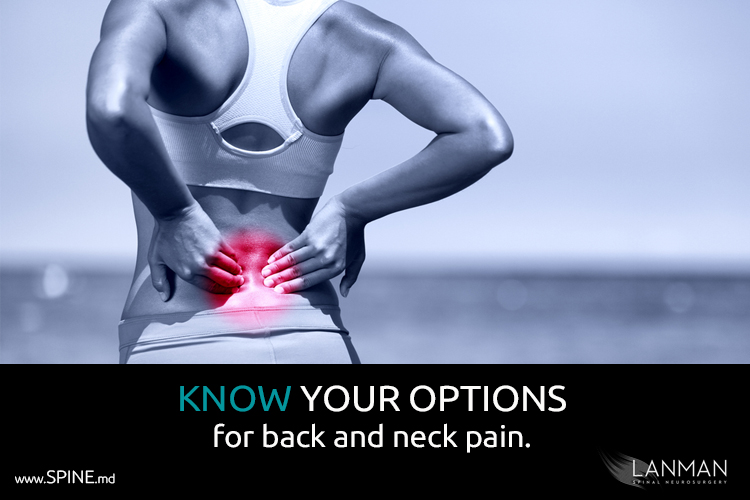It’s time to take time and get to know your options.
Some people are in such a hurry that they want simple answers for everything. When it concerns the pain in your neck or back, it’s time to take time and really get to know your options.
The first and most important point: surgery is not always the first and final answer. I have many friends and patients who have held off surgery until more conservative treatment options are exhausted. Patients who have chronic back or neck pain are initially prescribed six to eight weeks of physical therapy, exercise and other conservative non-surgical modalities of treatment.
A patient becomes a candidate for surgery when pain persists, and motion becomes limited. When it is clear that the only way to eliminate the pain generator is to correct the situation, then we take a look at surgical options.
The type of surgery will depend on the actual cause: a herniated disc, degenerative spondylosis (arthritis of the spine or facet joint arthritis, pinched nerves, or compressed spinal cord. We often find patients with any of these diagnoses; often with a combination of these issues.
Another factor in the surgical evaluation is the scope of damage: i.e., where is the damage and what will it take to fix it? Generally speaking, larger back surgeries and longer rehabilitation directly correlate with the amount of time that the patient has lived with the symptoms and left them untreated. If you have been living with back or neck pain and are diagnosed with severe disc degeneration, your recovery may take several months longer than a patient who has had a shorter duration of symptoms.
We also have to take careful consideration of what happens after surgery. As I have mentioned, postoperative rehabilitation can take several months to a year. Barring postoperative complications, we don’t just lay on a bed and wait until the sutures and bandages are removed. The healing process is a lot of work.
There’s always a chance that the patient experiences pain after the surgery. It is often more reasonable to continue with rehabilitation after spine surgery than to consider additional surgery. Some exceptions may come into play, such as if there has been an additional disk herniation or failed level. In most cases, however, a little pain is part of the process.
I often tell my patients that fifty percent of the outcome of spine surgery is from my work as a surgeon. The other fifty percent is from the patient’s work. A postoperative rehabilitation program often includes what I call the 4D Health Process:
• Exercise: We want to be careful during postoperative rehabilitation. I may start you on daily neck stretches and exercises of the upper shoulder muscle groups. I may give you a list of strengthening exercises for the whole body. Beyond exercising, I may pester you about getting your nose out of your media devices (phones, pads, laptops). The fact is, these devices encourage terrible habits that may create more problems later. I’ll encourage more time on desktop computers because you have more control over positioning (keyboard, monitors, mice). If you’re a bit of a ‘desk jockey’ you’ll probably want to invest in a good chair that helps you maintain good posture.
• Nutrition: It is a plain fact that nutrition plays a imperative part in your health. Is it really that much of a surprise to find that nutrition can help with postoperative healing? How about this: how about the combined effect of helping with the healing process AND preventing additional damage to your spine (and later surgeries). Consider that some foods cause inflammation – almost the same kind of reaction that the body has when there is an injury. Some foods not only decrease inflammation but also strengthen the body and supply it with the resources it needs to heal. I work with nutrition specialists – like Dr. Philip Goglia – who understand the systemic effects of food on the body and the rehabilitation process.
• Pain Management: Most likely, I will prescribe at least some pain management. Each case is unique, so I turn to skilled pain management physicians to create a plan that meets each patient’s case. In some cases, there may be a need for diagnostic and short-term anti-inflammatory medication, not just to help reduce pain, but also to encourage mobility during the healing process.
• Aging Management and Screening: Aging management should be part of the postoperative process. One area of concern is hormone levels. As we age, our bodies turn down hormone production. The drop in hormones may reduce metabolic processes which may reduce our ability to build muscle and burn fat. We fatigue faster and stay tired longer. A significant decline in hormones can also slow the healing process and prolong pain and discomfort. Thorough testing and screening tells us a lot about the body and gives us a roadmap on the best ways to optimize rehabilitation.
What I’ve described here is a process that can heal some patients without surgery. And even if surgery is still necessary, 4D helps put the body into the best condition possible for a healthy recovery after surgery.
The success of healing and rehabilitation depends greatly on how well the patient follows the postoperative prescription. What this means is how the patient does in terms of attention, consistency, and personal effort. Outcomes are always best when the patient takes the time to be fully committed to rehabilitation and focused on preserving an active lifestyle.
Take your time. Be greater than better!
###







